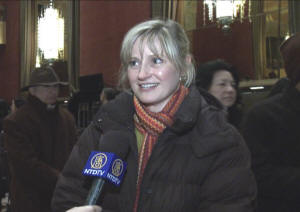(Clearwisdom.net) Divine Performing Arts has soared to new artistic heights as the dancers' intricate charm swept from the stage straight into the hearts and souls of about 20,000 audience members over the course of four shows in two cities on Chinese New Year's Eve, culminating in the crowning moment of its grand 80-city world tour de force.

Michelle DeCrosta (right), her mother and her friends
Michelle DeCrosta works for a biotechnology company. She was excited and called the Splendor "outstanding", "We saw last year's [show] and that was actually exceptional, [but] this was even more impressive than last year."
Caroline Lad, an actress and instructor
Caroline Lad, an actress and instructor not just "loved" the visual opulence of the show but also gravitated toward the spirituality, "It was quite wonderful, I especially enjoy the theme of the interconnectedness between the divine and the human being, I really loved that." She was inspired by the erhu solo "Hope" by highly acclaimed musician Qi Xiaochun. "I loved the woman who played the erhu, the melody and the soulfulness of that piece was just so moving, I really enjoyed it. I like the unity of the performance, there's a lot of soul involved."
The erhu is a popular traditional Chinese instrument capable of conveying a wide range of emotions. Whether the tempo is fast or slow, the erhu produces a hauntingly beautiful but also melancholy sound. Compared to other Chinese instruments, the erhu is relatively young with a history of only 1,000 years. It was introduced to China across the northern border. The name literally means "two-stringed barbarian instrument," because of its ethnic minority beginnings. Peasants used it to play folk songs describing daily life such as fishing and herding.
Although the erhu is sometimes called the two-string violin, it is held vertically, not horizontally, on the lap of a seated player. It is made of dense wood, such as rosewood or ebony, and consists of a small sound box covered with snakeskin--traditionally python--and a long slim neck slightly curved at the end. Two steel strings have replaced the traditional silk strings. The bamboo and white horsehair bow is permanently placed between the two strings.
This little box has many unique qualities that make it a difficult instrument to master. There is no fingerboard for finding the right key, and the strings are pressed but shouldn't touch the neck. The sound is produced when the bow, rosined to increase friction, is passed between the strings causing the snakeskin to vibrate; both sides of the bow are used to produce the sound. The strings are so close that they are played as if one.
Originally used only for ensemble performances or in a traditional Chinese orchestra, it was elevated to a solo instrument by Liu Tianhua (1895-1932). Liu introduced new bowing and fingering methods as he had also mastered the techniques of Western violin playing. This, at a time when the erhu was still considered a folk instrument and not played by "serious" musicians. His most famous and now classic tune is entitled "The Second Spring Reflects the Moon."
Over the past few years, DPA has seen consistent rise in erhu's popularity as it continues to enchant audiences everywhere with its mellow and expressive sound. Erhuist Qi Xiaochun says ancient Chinese culture promoted harmony between heaven and earth and respect for life and nature--values that are reflected in the Splendor.
Perhaps the phrase "less is more" rang true when Ms. Lad smiled and gave her last comment, "I don't know what to say about it, I'm at a loss for words!"
Category: Shen Yun Performing Arts






